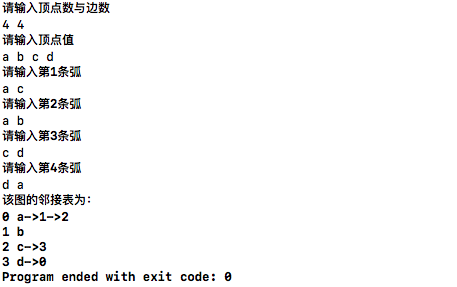#include<iostream>
#include<string>
#include<stdlib.h>
#define MAX_VERTEX_NUM 20 //最大顶点数
using namespace std;
typedef char VertexType; //顶点数据类型
//表结点
typedef struct ArcNode{
int adjvex; //该弧所指的顶点位置
struct ArcNode *nextarc; //指向下一条弧
string info; //该弧相关信息
}ArcNode;
//顶点
typedef struct VNode{
VertexType data;
ArcNode *firstarc;
}VNode,AdjList[MAX_VERTEX_NUM];
//邻接表
typedef struct {
AdjList vertices;
int vexnum, arcnum;
int kind;
}ALGraph;
//定位
int locateVex(ALGraph *g, char v)
{
for(int i = 0; i < g->vexnum; i++){
if(g->vertices[i].data == v){
return i;
}
}
return 0;
}
//创建
void CreateGraph(ALGraph *g)
{
ArcNode *l;
cout << "请输入顶点数与边数" << endl;
cin >> g->vexnum >> g->arcnum;
cout << "请输入顶点值" << endl;
for(int i = 0; i < g->vexnum; i++){
cin >> g->vertices[i].data;
}
char a , b;
for(int i = 0; i < g->arcnum; i++){
cout << "请输入第" << i + 1 << "条弧"<< endl;
cin >> a >> b;
l = new ArcNode;
int r1 = locateVex(g, a);
int r2 = locateVex(g, b);
l->adjvex = r2;
l->nextarc = g->vertices[r1].firstarc;
g->vertices[r1].firstarc = l;
}
}
//打印
void print(ALGraph *g)
{
cout << "该图的邻接表为:" << endl;
for(int i = 0; i < g->vexnum; i++){
cout << i << " " << g->vertices[i].data;
ArcNode *p = g->vertices[i].firstarc;
while(p){
cout << "->" << p->adjvex;
p = p->nextarc;
}
cout << endl;
}
}
int main()
{
ALGraph G;
CreateGraph(&G);
print(&G);
return 0;
}

